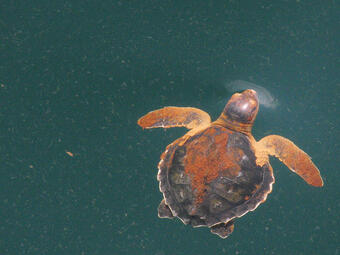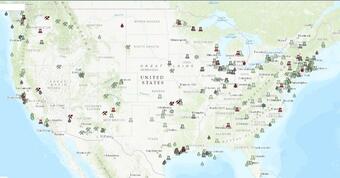Crude oil or oil distilled product (e.g. gasoline, diesel fuels, jet fuels) spills can occur during oil exploration, production, and transportation activities. Environmental impacts of spills are complex and can be difficult to assess. The chemical makeup of oil and oil products is diverse which affects oil behavior (e.g. volatilization, sinking). Oil degradation and fate are also influenced by environmental factors such as salinity, temperature, and surface vs underground spills. Oil can impact living organisms both directly (dermal contact, inhalation, ingestion) and indirectly (bioaccumulation in food sources, disruption of recreational activities). USGS scientists have decades of experience supporting assessment and restoration activities for the largest oil spills in U.S history, Exxon Valdez Oil Spill and Deepwater Horizon Oil Spill. Examples include oil spill remote sensing, vegetation surveys, ecotoxicological impacts, marsh ecology impacts, sea turtle modelling, immunosuppression of oiled biota, coral ecology, and avian and mammalian injury and recovery.
To learn more about how USGS science supports the NRDAR program contact Jo Ellen Hinck, the USGS NRDAR Coordinator.
Return to USGS Science for DOI Natural Resource Damage Assessment and Restoration (NRDAR) Program
Browse USGS publications related to NRDAR oil spill cases.
Examples of assessment and restoration projects are below.
Assessment Projects

- Histopathology of Bird Carcasses
Principal Investigator - Julia Lankton
- Ambient Water Concentrations of PAHs at an Oil Spill Using Semi-Permeable Membrane Devices (SPMDs)
Principal Investigator - David Alvarez
Principal Investigator - David Alvarez
- Remote Sensing Estimation of Surface Oil Volume During the 2010 Deepwater Horizon Oil Blowout in the Gulf of Mexico
Principal Investigator - Gregg Swayze
Restoration Projects

- Population Dynamics Model for Least Bell's Vireo Restoration after the Santa Clara River Oil Spill
Principal Investigator - Barbara Kus
- Enhancing Prey Availability for Wintering and Migrating Surf Scoters Damaged by the Cosco Busan Oil Spill
Principal Investigator - Susan De La Cruz
- Marbled Murrelet at Sea Survey, Cosco Busan Oil Spill
Principal Investigator - Josh Adams
- Detecting and Inferring Cause of Change in an Alaska Nearshore Marine Ecosystem
Principal Investigator - James L Bodkin

Explore the NRDAR Case Map and Document Library to learn more about individual cases.
Return to USGS Science for DOI Natural Resource Damage Assessment and Restoration (NRDAR) Program
Below are data or web applications associated with this project.
Annual Marbled Murrelet Abundance and Productivity Surveys Off Central California (Zone 6), 1999-2021 (ver. 4.0, May 2022)
Below are USGS publications for oil spills associated with specific NRDAR cases.
Abundance and productivity of marbled murrelets (Brachyramphus marmoratus) off central California during the 2019 breeding season
Prediction and inference of flow-duration curves using multi-output neural networks
Loggerhead sea turtle (Caretta caretta) diving changes with productivity, behavioral mode, and sea surface temperature
Council Monitoring and Assessment Program (CMAP): Inventory of existing water quality and habitat monitoring, and mapping metadata for Gulf of Mexico Programs
Modeling barrier island habitats using landscape position information
Advancing barrier island habitat mapping using landscape position information
Abundance and productivity of marbled murrelets (Brachyramphus marmoratus) off central California during the 2018 breeding season
Mississippi river sediment diversions and coastal wetland sustainability: Synthesis of responses to freshwater, sediment, and nutrient inputs
Florida Coastal Mapping Program—Overview and 2018 workshop report
Sympatry or syntopy? Investigating drivers of distribution and co‐occurrence for two imperiled sea turtle species in Gulf of Mexico neritic waters
Assessing the impact of open-ocean and back-barrier shoreline change on Dauphin Island, Alabama, at multiple time scales over the last 75 years
Shared habitat use by juveniles of three sea turtle species
Crude oil or oil distilled product (e.g. gasoline, diesel fuels, jet fuels) spills can occur during oil exploration, production, and transportation activities. Environmental impacts of spills are complex and can be difficult to assess. The chemical makeup of oil and oil products is diverse which affects oil behavior (e.g. volatilization, sinking). Oil degradation and fate are also influenced by environmental factors such as salinity, temperature, and surface vs underground spills. Oil can impact living organisms both directly (dermal contact, inhalation, ingestion) and indirectly (bioaccumulation in food sources, disruption of recreational activities). USGS scientists have decades of experience supporting assessment and restoration activities for the largest oil spills in U.S history, Exxon Valdez Oil Spill and Deepwater Horizon Oil Spill. Examples include oil spill remote sensing, vegetation surveys, ecotoxicological impacts, marsh ecology impacts, sea turtle modelling, immunosuppression of oiled biota, coral ecology, and avian and mammalian injury and recovery.
To learn more about how USGS science supports the NRDAR program contact Jo Ellen Hinck, the USGS NRDAR Coordinator.
Return to USGS Science for DOI Natural Resource Damage Assessment and Restoration (NRDAR) Program
Browse USGS publications related to NRDAR oil spill cases.
Examples of assessment and restoration projects are below.
Assessment Projects

- Histopathology of Bird Carcasses
Principal Investigator - Julia Lankton
- Ambient Water Concentrations of PAHs at an Oil Spill Using Semi-Permeable Membrane Devices (SPMDs)
Principal Investigator - David Alvarez
Principal Investigator - David Alvarez
- Remote Sensing Estimation of Surface Oil Volume During the 2010 Deepwater Horizon Oil Blowout in the Gulf of Mexico
Principal Investigator - Gregg Swayze
Restoration Projects

- Population Dynamics Model for Least Bell's Vireo Restoration after the Santa Clara River Oil Spill
Principal Investigator - Barbara Kus
- Enhancing Prey Availability for Wintering and Migrating Surf Scoters Damaged by the Cosco Busan Oil Spill
Principal Investigator - Susan De La Cruz
- Marbled Murrelet at Sea Survey, Cosco Busan Oil Spill
Principal Investigator - Josh Adams
- Detecting and Inferring Cause of Change in an Alaska Nearshore Marine Ecosystem
Principal Investigator - James L Bodkin

Explore the NRDAR Case Map and Document Library to learn more about individual cases.
Return to USGS Science for DOI Natural Resource Damage Assessment and Restoration (NRDAR) Program
Below are data or web applications associated with this project.
Annual Marbled Murrelet Abundance and Productivity Surveys Off Central California (Zone 6), 1999-2021 (ver. 4.0, May 2022)
Below are USGS publications for oil spills associated with specific NRDAR cases.

